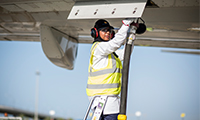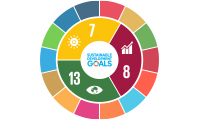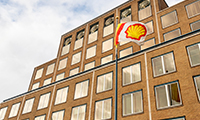Flaring
The flaring of natural gas wastes valuable resources and contributes to climate change. We are working hard to reduce flaring associated with oil and gas production.
Flaring is used to safely dispose of hydrocarbons that could otherwise pose a hazard to workers, nearby residents and facility equipment during non-routine occurrences. These occurrences include start-ups, process upsets, maintenance turnarounds, and equipment or power failures where production system pressure must be safely relieved.
In some situations, gas that is produced alongside oil, known as associated gas, may also be flared when there are insufficient or no facilities to gather the gas.
As a signatory to the World Bank’s "Zero Routine Flaring by 2030" initiative, Shell continues to actively pursue its 2015 commitment to eliminate associated gas flaring at its operations by 2030. Shell’s flaring and venting policy, as set out in our Health, Safety, Security, Environment and Social Performance (HSSE&SP) Control Framework, calls for facilities to meet strict performance criteria, including being designed to export, use or reinject associated gas.
Our policy also aims to minimise all types of flaring, managed through annually updated greenhouse gas and energy management plans.
Our flaring performance
Flaring of gas in our Upstream and Integrated Gas businesses contributed around 7% of our overall direct greenhouse gas emissions in 2018. More than 40% of this flaring took place at facilities where there was no infrastructure in place to capture the associated gas.
Flaring – upstream
million tonnes hydrocarbons flared
Enlarge imageOur upstream flaring decreased to 5.2 million tonnes of CO2 equivalent in 2018 from 8.2 million tonnes in 2017. In the Upstream business, reductions in the emissions from flaring were primarily a result of the divestment of the Majnoon asset in Iraq, and our continuing focus to bring additional gas-gathering facilities online in Nigeria to reach our goal of zero routine flaring by 2030.
Flaring – upstream
million tonnes CO2 equivalent
Enlarge imageAcross our Integrated Gas projects and plants, where flaring occurs only for operational reasons, greenhouse gas emissions from flaring have decreased by more than 30% since the start of 2016. This has primarily been due to reduced flaring in our Pearl gas-to-liquids plant (Qatar Shell GTL Ltd, QSGTL), which continues to deliver a multi-year flare reduction programme. Shell affiliate QGC Pty Limited has also implemented upstream flare reduction projects.
Iraq
In 2018, Shell completed the divestment of the Majnoon facilities (Shell interest 45%). Flare reduction programmes are continuing and have captured around 52% of the associated gas that would have been flared in the past. The gas is exported to a local power plant for electricity generation.
Basrah Gas Company (BGC, Shell interest 44%), is a non-operated joint venture with Iraq’s South Gas Company and Japan’s Mitsubishi. It continued to capture gas that would otherwise be flared from three non-Shell-operated oil fields in southern Iraq (Rumaila, West Qurna 1 and Zubair).
Nigeria
In Nigeria, the levels of hydrocarbons flared from Shell Petroleum Development Company’s joint-venture (SPDC JV – Shell interest 30%) facilities have fallen by 90% since the start of the programme in 2002. This decrease is mainly due to investing in facilities that capture the associated gas and commercialise it through domestic and export markets. Divestments also provided further reduction.
Flaring at SPDC JV facilities decreased by around 9% to 0.5 million tonnes in 2018 from 0.6 million tonnes in 2017, mainly due to improved compressor availability and facility outages in the Western Delta.
SPDC remains committed to eliminating associated gas flaring with reductions already realised from associated gas gathering initiatives such as Adibawa, Otumara and Bonny associated gas gathering projects. In 2019, the Forcados Yokri Integrated Project and Southern Swamp Associated Gas Gathering Solutions project are planned to come on-stream to add to these efforts.
Following successful engagements with the Federal Government of Nigeria, the SPDV JV has included the remaining flare sites in the Nigeria Flared Gas Commercialisation Program. This government-led programme is expected to address these remaining sites.
Nigeria LNG (Shell interest 25.6%), a non-operated joint venture, is identifying ways to reduce flaring by improving the reliability of equipment, reducing train start-up time and delivering operational improvements.
Qatar
In Qatar, at QSGTL’s Pearl gas-to-liquids plant, flaring takes place for operational reasons. In 2018, further enhancements have been made to the plant to limit the amount of operational flaring as part of a multi-year flare reduction programme (see Natural gas). Pearl has reduced its total flaring year on year since 2015 with flaring in 2018 nearly 50% lower than in 2015.
USA
We continued to take steps to reduce flaring at the SWEPI LP (a subsidiary of Shell Oil Company) Permian unconventional oil asset in the USA in 2018. For example, we are investing in operational upgrades that remove flares from well pad design and in new technologies to improve the reliability of our vapour recovery systems. Since 2017, we have invested around $10 million in operational improvements to reduce flaring at Permian. In 2018, we achieved a reduction in the volume of gas flared per total gas production of more than 80% compared to the 2017 levels.
Brunei
A review of greenhouse gas performance in 2018 highlighted the importance of flare reduction in Brunei Shell Petroleum (BSP, Shell interest 50%), a non-operated joint venture. Through detailed analysis across all facilities, BSP developed a multi-year target and plan to reduce flaring intensity.
Trinidad and Tobago
Atlantic LNG in Trinidad and Tobago implemented a flare reduction project in 2017 to recover LNG vapour (gas) during ship loading activities. A year later, the project continued to recover the gas, routing it back into the liquefaction process rather than to the flare.
 Our people
Our people
 Sustainable development goals
Sustainable development goals
 About our data
About our data
 Electricity
Electricity